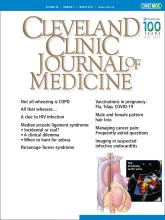ABSTRACT
Most patients with cancer experience pain at some point in the disease course due to the disease itself or its treatment, or both. Pain management can involve pharmacologic (nonopioid medications, adjuvants, and opioids) and nonpharmacologic (radiation therapy, interventional procedures) therapies. This article provides a treatment approach to reduce pain for patients with cancer and improve their quality of life.
- Copyright © 2021 The Cleveland Clinic Foundation. All Rights Reserved.
- Renato V. Samala, MD, MHPE, FACP, FAAHPM⇑
- Department of Palliative and Supportive Care, Taussig Cancer Institute, Cleveland Clinic, Cleveland, OH; Assistant Professor, Cleveland Clinic Lerner College of Medicine of Case Western Reserve University, Cleveland, OH
- Address:
Renato V. Samala, MD, MHPE, FACP, FAAHPM, Department of Palliative and Supportive Care, Taussig Cancer Institute, CA-53, Cleveland Clinic, 9500 Euclid Avenue. Cleveland, OH 44195; samalar{at}ccf.org
- Ruth L. Lagman, MD, MPH, MBA, FACP, FAAHPM
- Sina Najafi, DO
- Flannery Fielding, CNP, MSN
ABSTRACT
Most patients with cancer experience pain at some point in the disease course due to the disease itself or its treatment, or both. Pain management can involve pharmacologic (nonopioid medications, adjuvants, and opioids) and nonpharmacologic (radiation therapy, interventional procedures) therapies. This article provides a treatment approach to reduce pain for patients with cancer and improve their quality of life.
- Copyright © 2021 The Cleveland Clinic Foundation. All Rights Reserved.






